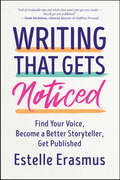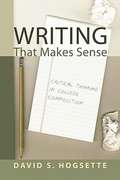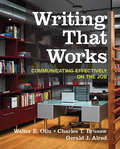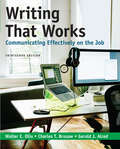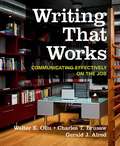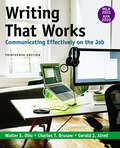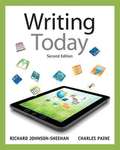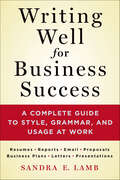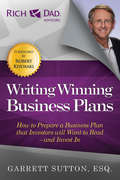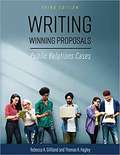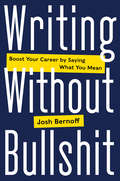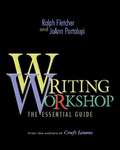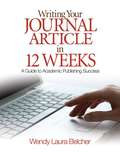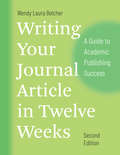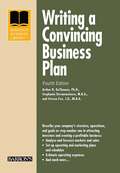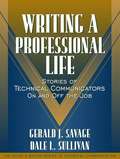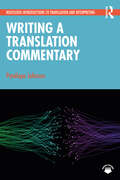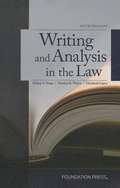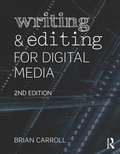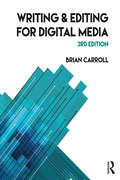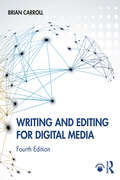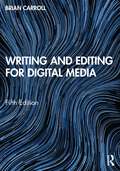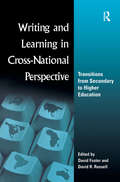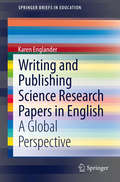- Table View
- List View
Writing That Gets Noticed: Find Your Voice, Become a Better Storyteller, Get Published
by Estelle ErasmusSelected as one of the Best Books for Writers by Poets & Writers Successful essayist, columnist, writing instructor, and editor Estelle Erasmus will show you how to find your voice, write stellar pieces, and get published. In real-world, experience-based chapters, she coaches you to: • mine your life for ideas and incubate those ideas • choose the perfect format — essay, op-ed, feature article, and more • research publications and follow editor etiquette • craft a perfect pitch • protect your psyche from rejection • revise your work for maximum impact • deliver what you promise, protect your work, and get paid
Writing That Makes Sense: Critical Thinking In College Composition
by David S. HogsetteWriting That Makes Sense takes students through the basics of the writing process and critical thinking, and it teaches them how to write various types of academic essays they are likely to encounter in their academic careers. Drawing on nearly twenty years of experience in teaching college composition and professional writing, David S. Hogsette combines relevant writing pedagogy and practical assignments with the basics of critical thinking and logical thought to provide students with step-by-step guides for successful writing in academia. Writing That Makes Sense includes many professional essays and articles from a variety of voices often underrepresented in academia today, thus introducing students to a wider intellectual diversity. Students will also benefit from a chapter on information literacy that provides practical tips on engaging the research process and writing research papers.
Writing That Works
by Gerald J. Alred Charles T. Brusaw Walter E. OliuCountless real-world model documents contextualized by clear rhetorical instruction and a focus on professional ethics make Writing That Works the foundational standard for professional writing. More than ever, this streamlined twelfth edition reflects the role of technology in the office and the classroom, showcasing the most current types of business documents online and in print, providing succinct guidelines on selecting the appropriate medium for your document, communication, or presentation, and giving advice on landing and keeping a job in today's economy. Now also available as an e-book, Writing that Works offers robust but accessible coverage at an affordable price.
Writing That Works: Communicating Effectively On The Job
by Gerald Alred Charles Brusaw Walter OliuMore than ever, Writing That Works is the right choice for the most up-to-date coverage of business writing. Real-world model documents are grounded in their rhetorical contexts to guide students in navigating the increasingly complex world of business writing. Now in full-color, the thirteenth edition continues to reflect the central role of technology in the office and the classroom, showcasing the most current types of business documents online and in print, providing succinct guidelines on selecting the appropriate medium for your document, communication, or presentation, and featuring new advice on creating a personal brand as part of a successful job search. Also available as an e-book and in loose-leaf, Writing that Works offers robust but accessible coverage at an affordable price.
Writing That Works: Communicating Effectively On The Job
by Gerald J. Alred Charles T. Brusaw Walter E. OliuCountless real-world model documents contextualized by clear rhetorical instruction and a focus on professional ethics make Writing That Works the foundational standard for professional writing. More than ever, this streamlined twelfth edition reflects the role of technology in the office and the classroom, showcasing the most current types of business documents online and in print, providing succinct guidelines on selecting the appropriate medium for your document, communication, or presentation, and giving advice on landing and keeping a job in today’s economy.
Writing That Works: Communicating Effectively on the Job with 2020 APA and 2021 MLA Updates
by Gerald J. Alred Charles T. Brusaw Walter E. OliuThis ebook has been updated to provide you with the latest guidance on documenting sources in MLA style and follows the guidelines set forth in the MLA Handbook, 9th edition (April 2021).More than ever, Writing That Works is the right choice for the most up-to-date coverage of business writing. Real-world model documents are grounded in their rhetorical contexts to guide students in navigating the increasingly complex world of business writing. Now in full-color, the thirteenth edition continues to reflect the central role of technology in the office and the classroom, showcasing the most current types of business documents online and in print, providing succinct guidelines on selecting the appropriate medium for your document, communication, or presentation, and featuring new advice on creating a personal brand as part of a successful job search. Also available as an e-book and in loose-leaf, Writing that Works offers robust but accessible coverage at an affordable price.
Writing Today
by Richard Johnson-Sheehan Charles PaineWith a clear and easy-to-read presentation, visual instruction and pedagogical support, Writing Today is a practical and useful guide to writing for college and beyond. This text teaches how to transfer their writing skills to careers. By teaching kinds of writing (analyses, reports, proposals, etc. ), strategies for writing (narration, comparison, argumentation, etc. ), and processes for writing (planning, drafting, revising, etc. ), Writing Today provides the writer with tools they can mix and match as needed to respond effectively to many writing situations.
Writing Well for Business Success: A Complete Guide to Style, Grammar, and Usage at Work
by Sandra E. LambSo much of success in business depends on writing well. From résumés to reports, proposals to presentations,Writing Well for Business Success will help you communicate your ideas clearly, quickly and effectively.It will help you: -Distill your message into a well-targeted statement-Ace the elements of style-Write what you want to say in emails, business plans and more-Master the tricks of editing yourselfPresented in author Sandra Lambs lighthearted and easy accessible style, this little book is an essential desk reference guide for the modern working world.
Writing Winning Business Plans
by Garrett SuttonTo win in business requires a winning business plan. To write a winning business plan requires reading Garrett Sutton's dynamic book on the topic. Writing Winning Business Plans provides the insights and the direction on how to do it well and do it right.Rich Dad/Poor Dad author Robert Kiyosaki says, "The first step in business is a great business plan. It must be a page turner that hooks and holds a potential investor. Garrett Sutton's Writing Winning Business Plans is THE book for key strategies on preparing winning plans for both business and real estate ventures.Crisply written and featuring real life illustrative stories, Writing Winning Business Plans discusses all the key elements for a successful plan. Topics include focusing your business vision, understanding your financials and analyzing your competition. Also covered are how to really use your business plan as a tool and how to attract funding for your new or existing businesses.As business plan competitions become more popular around the world Writing Winning Business Plans also discusses how to enter and how to win these ever more lucrative contests.In addition, how to quickly interest a potential investor, also known as the elevator pitch, is explained. And, as opportunities arise around the world, how to present your plan in various countries is explored.Writing Winning Business Plans is the complete compendium for this essential business rite of passage - preparing a winning plan.
Writing Winning Proposals: Public Relations Cases
by Thomas Hagley Rebecca DeemerWriting Winning Proposals: Public Relations Cases teaches students, as well as practitioners, how to conceptualize and write public relations plans and proposals from the perspective of the plan reviewer — typically non-public relations practitioners. <P><P> The process illustrated within the book is designed to win approval from the plan reviewers and to foster a path for award-winning plan writing. The book thoroughly describes components of the plan, and then provides many actual cases to further demonstrate the strategy and thought process behind plan construction. The cases have multiple suggested writing assignments, role plays, and case problems. These help students and practitioners explore progression of plan construction in various avenues where public relations may be required and practiced. Cases highlighting community relations and engagement, media relations, employee relations and empowerment, government relations, crisis management and prevention, risk communication, corporate communication, social media implementation, arts and entertainment, corporate communication, social responsibility, promotional endeavors, and event planning are all included. <P><P> Writing Winning Proposals is ideal for introductory public relations courses, as well as courses in public relations writing, plans, and campaigns. It can also be used as an academic text supplement, a campaigns workbook, or for strategic planning. <P><P> Rebecca A. Gilliland is a distinguished professor of service learning and an associate professor of communication at the University of Indianapolis. A Fulbright Scholar and a Plank Fellow, Professor Gilliland has traveled the United States and around the world in an effort to stay current in the public relations industry while studying her areas of interest. She advises a nationally award-winning student run public relations firm and has taught numerous public relations classes. She has worked abroad and domestically, in sports promotions, corporate public relations, and in the non-profit sector. She is accredited in public relations and earned a doctorate in education with cognates in both public relations and communication studies. <P><P> Thomas R. Hagley is a senior instructor of public relations retired from the University of Oregon’s School of Journalism and Communication. A recipient of the school’s Jonathan Marshall Award for innovative teaching, he has taught more than 50 classes in public relations principles, advanced writing, strategic planning, and campaigns to a total enrollment of more than 1,000 students. His work as an educator was preceded by 30 years of professional experience as an executive with Alumax, Inc., Hill and Knowlton, Inc., his own consulting business, Alcoa, as publications chief for Newport News Shipbuilding and Dry Dock Co., and general assignment/investigative reporter for The Cleveland Plain Dealer.
Writing Without Bullshit: Boost Your Career by Saying What You Mean
by Josh BernoffJoining the ranks of classics like The Elements of Style and On Writing Well, Writing Without Bullshit helps professionals get to the point to get ahead. It’s time for Writing Without Bullshit.Writing Without Bullshit is the first comprehensive guide to writing for today’s world: a noisy environment where everyone reads what you write on a screen. The average news story now gets only 36 seconds of attention. Unless you change how you write, your emails, reports, and Web copy don’t stand a chance.In this practical and witty book, you’ll learn to front-load your writing with pithy titles, subject lines, and opening sentences. You’ll acquire the courage and skill to purge weak and meaningless jargon, wimpy passive voice, and cowardly weasel words. And you’ll get used to writing directly to the reader to make every word count.At the center of it all is the Iron Imperative: treat the reader’s time as more valuable than your own. Embrace that, and your customers, your boss, and your colleagues will recognize the power and boldness of your thinking.Transcend the fear that makes your writing weak. Plan and execute writing projects with confidence. Manage edits and reviews flawlessly. And master every modern format from emails and social media to reports and press releases.Stop writing to fit in. Start writing to stand out. Boost your career by writing without bullshit.
Writing Workshop: The Essential Guide
by Ralph Fletcher Ralph J. Fletcher Joann PortalupiIs the writing workshop the only way to teach writing? No. There are a variety of approaches or programs, but none of them matches the writing workshop when it comes to growing strong writers. That's why, despite the pressures of testing, the writing workshop has endured and even flourished in thousands of schools across the country. Today we face a time when as many as ten million new teachers are entering the profession. It is for these teachers, and others who are unfamiliar with writing workshop, that Ralph Fletcher and JoAnn Portalupi wrote this book - as a way to introduce and explain the writing workshop . . . to reveal what a potent tool the writing workshop can be for empowering young writers. Above all Writing Workshop is a practical book, providing everything a teacher needs to get the writing workshop up and running. In clear language, Fletcher and Portalupi explain the simple principles that underlie the writing workshop and explore the major components that make it work. Each chapter addresses an essential element, then suggests five or six specific things a teacher can do to implement the idea under discussion. There's also a separate chapter entitled "What About Skills," which shows how to effectively teach skills in the context of writing. The book closes with practical forms in the appendixes to ensure that the workshop runs smoothly. Fletcher and Portalupi's twenty-plus years working with teachers have convinced them that there is no better way to teach writing. This important book is the culmination of all their years of effort, a synthesis of their best thinking on the subject.
Writing Your Journal Article in Twelve Weeks: A Guide to Academic Publishing Success
by Wendy Laura BelcherA comprehensive, well-written and beautifully organized book on publishing articles in the humanities and social sciences that will help its readers write forward with a first-rate guide as good company. ' - Joan Bolker, author of Writing Your Dissertation in Fifteen Minutes a Day `Humorous, direct, authentic ... a seamless weave of experience, anecdote, and research. ' - Kathleen McHugh, professor and director of the UCLA Center for the Study of Women Wendy Laura Belcher's Writing Your Journal Article in Twelve Weeks: A Guide to Academic Publishing Success is a revolutionary approach to enabling academic authors to overcome their anxieties and produce the publications that are essential to succeeding in their fields. Each week, readers learn a particular feature of strong articles and work on revising theirs accordingly. At the end of twelve weeks, they send their article to a journal. This invaluable resource is the only guide that focuses specifically on publishing humanities and social science journal articles.
Writing Your Journal Article in Twelve Weeks: A Guide to Academic Publishing Success (Chicago Guides to Writing, Editing and Publishing)
by Wendy Laura Belcher"Wow. No one ever told me this!" Wendy Laura Belcher has heard this countless times throughout her years of teaching and advising academics on how to write journal articles. Scholars know they must publish, but few have been told how to do so. So Belcher made it her mission to demystify the writing process. The result was Writing Your Journal Article in Twelve Weeks, which takes this overwhelming task and breaks it into small, manageable steps. For the past decade, this guide has been the go-to source for those creating articles for peer-reviewed journals. It has enabled thousands to overcome their anxieties and produce the publications that are essential to succeeding in their fields. <p><p>With this new edition, Belcher expands her advice to reach beginning scholars in even more disciplines. She builds on feedback from professors and graduate students who have successfully used the workbook to complete their articles. A new chapter addresses scholars who are writing from scratch. <p><p>This edition also includes more targeted exercises and checklists, as well as the latest research on productivity and scholarly writing. Writing Your Journal Article in Twelve Weeks is the only reference to combine expert guidance with a step-by-step workbook. Each week, readers learn a feature of strong articles and work on revising theirs accordingly. Every day is mapped out, taking the guesswork and worry out of writing. There are tasks, templates, and reminders. At the end of twelve weeks, graduate students, recent PhDs, postdoctoral fellows, adjunct instructors, junior faculty, and international faculty will feel confident they know that the rules of academic publishing and have the tools they need to succeed.
Writing a Convincing Business Plan (Barron's Business Library)
by Steven Fox Arthur DeThomas Stephanie DerammelaereA sound and convincing business plan is an entrepreneur’s important first step in starting up a profitable business. It’s also a prerequisite for getting financing and attracting investors. A sound business plan describes the business operations and goals, analyzes and forecasts markets and sales, sets up operating and marketing plans and schedules, and estimates operating expenses. This book shows how to organize and write a logical, business-savvy, and professionally polished business plan that can be presented to potential investors and financial institutions.
Writing a Professional Life: Stories of Technical Communicators On and Off the Job
by Gerald J. Savage Dale L. SullivanThis is the first collection of narratives by practicing technical communicators telling their own personal stories about the workplace and their lives on the job. The authors portray a wide range of jobs: writers, editors, interface designers, marketing writers, and trainers working in 9 different technical fields, including software, R&D, engineering , medicine, transportation, and telecommunications. The stories vividly demonstrate the unique power of narrative as a teaching and learning tool. Unlike fabricated cases, these real-life narratives show new and veteran technical writers at work on the job, dealing with tasks, clients, and co-workers, and revealing their insights, values, and attitudes about their work. The stories also show the skills required in the profession and the ethical and other issues raised in the course of the workday. For anyone interested in technical communication and professional writing.
Writing a Translation Commentary (Routledge Introductions to Translation and Interpreting)
by Penélope JohnsonThis essential textbook is a step-by-step guide to how to write a self-reflective translation commentary, a key requirement of most courses on translation. Starting with source text analysis, it guides students in how to set out a translation strategy and goes through the most common challenging issues encountered, thus enabling students to set out their translation priorities in an informed manner. Throughout each chapter, there are boxes summarising key concepts and suggestions of tasks and activities, as well as recommendations for further reading. The book is supplemented by online resources for students and teachers on the translation studies portal. There are nine PowerPoints based on the chapters of the book that could be used for teaching or self-study. There are also downloadable versions of sample assessment rubrics, tables for example selection, and checklists. Based on real life examples of students' work in different language combinations, drawing on the author's years of experience of teaching commentary writing, this book focuses on several types of language mediation that go beyond the written word, such as interpreting, audiovisual translation, localisation, and transcreation. This is a vital textbook for students writing commentaries on translation and interpreting courses, a useful resource for supervisors providing students with guidance on how to write a balanced, articulate, and convincing commentary and a handy reference for professional translators and interpreters needing to explain their translation decisions to clients.
Writing about Archaeology
by Graham ConnahIn this book, Graham Connah offers an overview of archaeological authorship: its diversity, its challenges, and its methodology. Based on his own experiences, he presents his personal views about the task of writing about archaeology. The book is not intended to be a technical manual. Instead, Connah aims to encourage archaeologists who write about their subject to think about the process of writing. He writes with the beginning author in mind, but the book will be of interest to all archaeologists who plan to publish their work. Connah's overall premise is that those who write about archaeology need to be less concerned with content and more concerned with how they present it. It is not enough to be a good archaeologist. One must also become a good writer and be able to communicate effectively. Archaeology, he argues, is above all a literary discipline.
Writing and Analysis in the Law, Sixth Edition
by Helene S. Shapo Marilyn R. Walter Elizabeth FajansA standard-setter in American legal education, Writing and Analysis in the Law provides a guide to legal writing, focusing on the importance of clear organization in written communications. Developed as a textbook for a first-year law school course, and is successful in courses for foreign LLM students, the book introduces law students to analyzing and writing about legal authority in cases and statutes. It discusses the structure and persuasive techniques of effective argumentation. The book makes effective use of high-quality and illustrative examples and writing exercises. It also includes access to helpful PowerPoint slides for use in the classroom and class preparation. Lucid, compact, and up-to-date, this work consistently draws acclaim in law schools across the country. <P><P>The sixth edition has been streamlined and designed to be reader friendly: it uses white space, bullet points, tabulation, and headings that chunk information to enable student to grasp information efficiently.
Writing and Editing for Digital Media
by Brian CarrollWriting and Editing for Digital Media, 2nd edition, teaches students how to write effectively for digital spaces--whether crafting a story for a website, blogging or using Twitter to cover a breaking news story or event. The lessons and exercises in each chapter help students build a solid understanding of the ways that digital communications have introduced opportunities for dynamic storytelling and multi-directional communication. Writing and Editing for Digital Media also addresses the graphical, multimedia, hypertextual and interactive elements that come into play when writing for digital platforms and designing digital spaces. The book teaches students not only to create content, but also to become careful, creative managers of that content. Based on Brian Carroll's extensive experience teaching the course, this revised and updated edition pays particular attention to opportunities presented by the growth of social media and mobile media. Chapters aim to: Assist digital communicators in understanding the social networked, increasingly mobile, always-on, geomapped, personalized media ecosystem; Help writers across multiple communication fields (journalism, marketing, PR, technical writing) make the transition from print to digital; Teach communicators to approach storytelling from a multimedia, multi-modal, interactive perspective. A companion website with exercises and assignments gives students the tools they need to put theory into practice.
Writing and Editing for Digital Media
by Brian CarrollWriting and Editing for Digital Media teaches students how to write effectively for digital spaces—whether writing for an app, crafting a story for a website, blogging, or using social media to expand the conversation. The lessons and exercises in each chapter help students build a solid understanding of the ways that digital communication has introduced opportunities for dynamic storytelling and multi-directional communication. With this accessible guide and accompanying website, students learn not only to create content, but also to become careful, creative managers of that content. Updated with contemporary examples and pedagogy, including examples from the 2016 presidential election, and an expanded look at using social media, the third edition broadens its scope, helping digital writers and editors in all fields, including public relations, marketing, and social media management. Based on Brian Carroll's extensive experience teaching a course of the same name, this revised and updated edition pays particular attention to opportunities presented by the growth of social media and mobile media. Chapters aim to: Assist digital communicators in understanding the socially networked, increasingly mobile, always-on, geomapped, personalized media ecosystems; Teach communicators to approach storytelling from a multimedia, multi-modal, interactive perspective; Provide the basic skill sets of the digital writer and editor, skill sets that transfer across all media and most communication and media industries, and to do so in specifically journalistic and public relations contexts; Help communicators to put their audiences first by focusing attention on user experience, user behavior, and engagement with their user bases; Teach best practices in the areas of social media strategy, management, and use.
Writing and Editing for Digital Media
by Brian CarrollIn this new edition, Brian Carroll explores writing and editing for digital media with information about voice, style, media formats, and content development, combining hands-on exercises with new sections on idea generation, multi-modal storytelling, podcasting, and information credibility. Carroll explains and demonstrates how to effectively write for digital spaces – whether crafting a story for a website, writing for an app, blogging, or using social media to expand the conversation. Each chapter features lessons and exercises through which students can build a solid understanding of the ways that digital communication provides opportunities for dynamic storytelling and multi-directional communication. Updated with contemporary examples and new pedagogy, the fourth edition broadens its scope, helping digital writers and editors in all fields, including public relations, marketing, and social media management. Writing and Editing for Digital Media is an ideal handbook for students from all backgrounds who are looking to develop their writing and editing skills for this ever-evolving industry.
Writing and Editing for Digital Media
by Brian CarrollIn this fifth edition, Brian Carroll explores writing and editing for digital media with essential information about voice, style, media formats, ideation, story planning, and storytelling. Carroll explains and demonstrates how to effectively write for digital spaces and combines hands-on, practical exercises with new material on podcasting, multi-modal storytelling, misinformation and disinformation, and writing specifically for social media. Each chapter features lessons and exercises through which students can build a solid understanding of the ways that digital communication provides opportunities for dynamic storytelling and multi-directional communication. Broadened in scope, this new edition also speaks to writers, editors, public relations practitioners, social media managers, marketers, as well as to students aspiring to these roles. Updated with contemporary examples and new pedagogy throughout, this is the ideal handbook for students seeking careers in digital media, particularly in content development and digital storytelling. It is an essential text for students of media, communication, public relations, marketing, and journalism who are looking to develop their writing and editing skills for these ever-evolving fields and professions. This book also has an accompanying eResource that provides additional weekly activities, exercises, and assignments that give students more opportunity to put theory into practice.
Writing and Learning in Cross-national Perspective: Transitions From Secondary To Higher Education
by David Foster David R. RussellDespite the increasingly global implications of conversations about writing and learning, U.S. composition studies has devoted little attention to cross-national perspectives on student writing and its roles in wider cultural contexts. Caught up in our own concerns about how U.S. students make the transition as writers from secondary school to postsecondary education, we often overlook the fact that students around the world are undergoing the same evolution. How do the students in China, England, France, Germany, Kenya, or South Africa--the educational systems represented in this collection--write their way into the communities of their chosen disciplines? How, for instance, do students whose mother tongue is not the language of instruction cope with the demands of academic and discipline-specific writing? And in what ways is U.S. students' development as academic writers similar to or different from that of students in other countries? With this collection, editors David Foster and David R. Russell broaden the discussion about the role of writing in various educational systems and cultures. Students' development as academic writers raises issues of student authorship and agency, as well as larger issues of educational access, institutional power relations, system goals, and students' roles in society. The contributors to this collection discuss selected writing purposes and forms characteristic of a specific national education system, describe students' agency as writers, and identify contextual factors--social, economic, linguistic, cultural--that shape institutional responses to writing development. In discussions that bookend these studies of different educational structures, the editors compare U.S. postsecondary writing practices and pedagogies with those in other national systems, and suggest new perspectives for cross-national study of learning/writing issues important to all educational systems. Given the worldwide increase in students entering higher education and the endless need for effective writing across disciplines and nations, the insights offered here and the call for further studies are especially welcome and timely.
Writing and Publishing Science Research Papers in English
by Karen EnglanderThis book provides a comprehensive review of the current knowledge on writing and publishing scientific research papers and the social contexts. It deals with both English and non-Anglophone science writers, and presents a global perspective and an international focus. The book collects and synthesizes research from a range of disciplines, including applied linguistics, the sociology of science, sociolinguistics, bibliometrics, composition studies, and science education. This multidisciplinary approach helps the reader gain a solid understanding of the subject. Divided into three parts, the book considers the context of scientific papers, the text itself, and the people involved. It explains how the typical sections of scientific papers are structured. Standard English scientific writing style is also compared with science papers written in other languages. The book discusses the strengths and challenges faced by people with different degrees of science writing expertise and the role of journal editors and reviewers.
